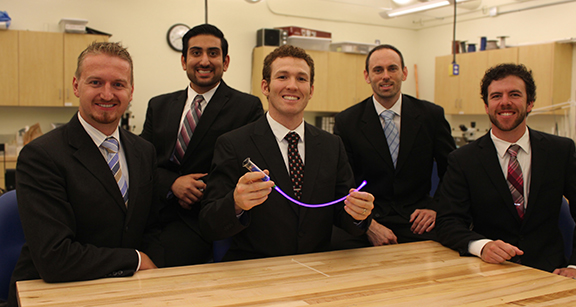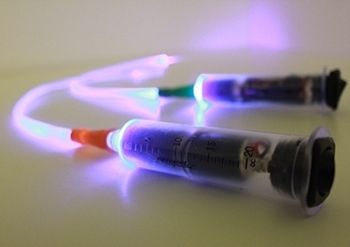Fueling the "Maker Movement"

Academia is hierarchical, a space where faculty are judged by the size of their NIH grants and research portfolios. But entrepreneurs can have just as great an impact on patient care and the bottom line – and who better to tinker and dream than students?
Nate Rhodes, a master’s student in bioengineering at the University of Utah, wondered if catheters, which are the leading cause of hospital-acquired infections, could instead be a solution to preventing infection. The thin tubes, used to deliver or drain fluids, are pervasive in medicine. Catheter manufacturers currently use chemical coatings to keep bacteria in check, and providers take care to insert them under sterile conditions and keep them clean. But the coatings aren’t durable; they wear off over time, says Rhodes. “We wanted something that was better at killing bacteria and that didn’t require such close monitoring, something that could be used anywhere in world.”
That is exactly the kind of thinking encouraged by Bench-to-Beside (B2B), an annual competition and incubator program at the U. that coaxes the inventions of medical, engineering and business students into marketable medical devices. “If you can develop a device that’s affordable to most of the world, but built to U.S. standards, you’re benefitting not just developing countries but helping to improve and lower the cost of health care in this country,” says John Langell, M.D., Ph.D., M.B.A., director of the U.’s Center for Medical Innovation.
Catheter-related infections not only compromise patient care, they are also costly. More than $400 million is spent treating the most prevalent, urinary tract variety each year. And now that Medicare is no longer reimbursing health care institutions for care related to preventable complications, such as infections, hospitals must pay the tab.
Rhodes and a team of engineering and medical students started by searching the academic literature for existing technologies but they didn’t find anything that could be adapted to a catheter. Then they stumbled across a study by a group in Glasgow who used visible light—one wavelength of it—to kill bacteria in burn wards. “They used it in the ambient lighting in the ceiling, and we thought, ‘Why hasn’t anyone tried this before with catheters?’” Rhodes said. “We decided, ‘Let’s be the first.’”
B2B is unique in that it’s an incubator for new ideas rather than just a competition. With philanthropic support it provides seed funding for student teams. Its professional and faculty mentors represent diverse fields, from business and law to medicine and biotechnology. “No one else in country offers anything like it,” Rhodes said. His team was coached by experts on 3D modeling and given legal advice on how to file patents. Business faculty gave them crash courses in how to value a company that doesn’t have a sales record, and the optimal time for hiring a CEO.
 Their invention: The bacteria-killing LIGHT LINE Catheter is being tested in the lab. Early results show the device, equipped with a high-intensity narrow spectrum light, is harmless to human cells, but kills 99.99 percent of bacteria. The startup company they created, Veritas Medical LLC has secured more than $100,000 in cash prizes and grants from national competitions. They’re in negotiations with a major device maker to commercialize the property and hope to get it FDA approved and to market by 2016. And every penny Veritas earns goes to its founders who were all undergraduate students when they started the project. “This is how we nurture tomorrow’s inventors and speed discovery of life-sustaining technologies while lowering health costs. It’s how we improve health care through innovation,” Langell said.
Their invention: The bacteria-killing LIGHT LINE Catheter is being tested in the lab. Early results show the device, equipped with a high-intensity narrow spectrum light, is harmless to human cells, but kills 99.99 percent of bacteria. The startup company they created, Veritas Medical LLC has secured more than $100,000 in cash prizes and grants from national competitions. They’re in negotiations with a major device maker to commercialize the property and hope to get it FDA approved and to market by 2016. And every penny Veritas earns goes to its founders who were all undergraduate students when they started the project. “This is how we nurture tomorrow’s inventors and speed discovery of life-sustaining technologies while lowering health costs. It’s how we improve health care through innovation,” Langell said.
With nearly 50 teams now competing, up from 14 in 2011, B2B is the most popular program at the 3-year-old Center for Medical Innovation (CMI). Roughly 600 students have gone through the program, producing 87 technologies and 21 spin-off companies. But B2B is just one of CMI’s programs designed to nurture entrepreneurs—students, residents and faculty. BioInnovate is a master of bioengineering degree track attracting dozens of tech venture-minded graduate and post-doctoral students each year. This spring also marked the inaugural Games4Health Challenge, a design competition focused on therapeutic video games. Also under construction is a “gap lab,” or simulation center, where gamers can test their designs on patients. The market for health games and apps is huge; Price Waterhouse Coopers pegs its value at $4 billion. Peruse the app store and you’ll already find a glut of apps that promise to help you lose weight, avoid exerting yourself on “bad air” days, or manage your blood sugar. “Consumers have lots of choice, but they have no real way of determining which game is best, or clinically works. The Food and Drug Administration isn’t regulating them,” says Langell. “We’re studying these games, doing research, which the university is really good at, and giving them efficiency ratings.”
By the Numbers
The Center for Medical Innovation, which has grown five-fold since created three years ago, has a two-year return on investment of 285 percent, based on acquired research grants and philanthropic underwriting. Here’s a recap of accomplishments:
19 faculty patents filed
57 student patents filed
10 University patents licensed
3 clinical trials
25 tech ventures from CMI-facilitated technologies
